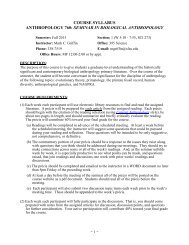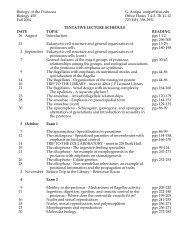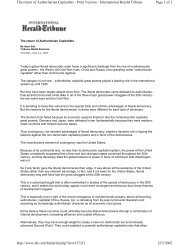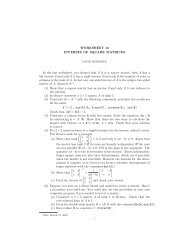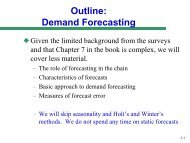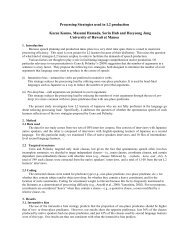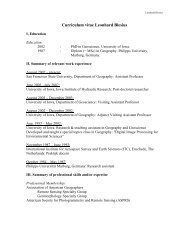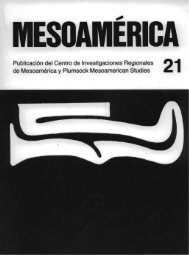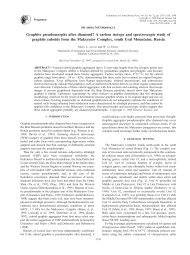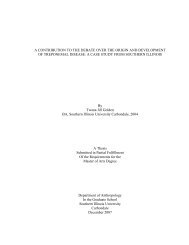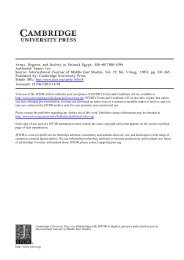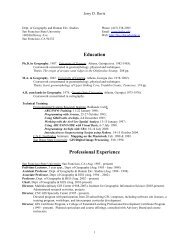Consumption Based Asset Pricing - San Francisco State University
Consumption Based Asset Pricing - San Francisco State University
Consumption Based Asset Pricing - San Francisco State University
Create successful ePaper yourself
Turn your PDF publications into a flip-book with our unique Google optimized e-Paper software.
<strong>San</strong> <strong>Francisco</strong> <strong>State</strong> <strong>University</strong> Michael Bar<br />
<strong>Consumption</strong> <strong>Based</strong> <strong>Asset</strong> <strong>Pricing</strong><br />
1 Introduction<br />
Traditional finance studies financial markets and asset prices in isolation from other markets<br />
for goods and services. Dynamic General Equilibrium theory used in macro economics<br />
(Stochastic Neoclassical Growth Model) however, is a framework that allows studying all<br />
markets and all trades in goods, services, and financial assets jointly. These notes provide a<br />
short introduction into the uni theory of macroeconomics and finance - macrofinance.<br />
2 Model<br />
The model we use is similar to the stochastic NGM, with inelastic labor supply. The representative<br />
household earns income from wages and from =1 assets. <strong>Asset</strong> holding<br />
at time is , where =1 2 are assets. <strong>Asset</strong> prices are , and dividends . The<br />
household’s problem is<br />
+<br />
=1<br />
TheLagrangefunctionis:<br />
(<br />
∞X<br />
L =0 () −<br />
F.O.C.<br />
=0<br />
<br />
X<br />
+1 = +<br />
∞X<br />
=0<br />
<br />
"<br />
max 0<br />
{+1}<br />
=1; =01<br />
+<br />
=1<br />
X<br />
=1<br />
+<br />
X<br />
=1<br />
X<br />
+1 − −<br />
∞X<br />
()<br />
=0<br />
<br />
X<br />
=1<br />
−<br />
X<br />
=1<br />
<br />
[] : 0 () − =0 ∀ =12 [+1] : − + +1 (+1 + +1) =0 ∀ =1 ; ∀ =12 Combining the conditions for +1 and +1, gives the Euler Equation:<br />
− 0 () + +1 0 (+1)(+1 + +1) =0<br />
Rearranging, gives the consumption based asset pricing equation:<br />
¸<br />
The term<br />
= <br />
∙<br />
0 (+1)<br />
0 () (+1 + +1)<br />
+1 ≡ 0 (+1)<br />
0 ()<br />
1<br />
#)<br />
(1)
is called the stochastic discount factor.<br />
The asset pricing formula (1) can be rewritten as in terms of (gross) return:<br />
1+ = +1 = +1 + +1<br />
1= (+1+1) (2)<br />
where +1 is the gross return (such as 1.05) on asset and is the net return (such as<br />
0.05 or 5%) on asset . Equation (2) is a very general asset pricing formula. Most of the<br />
theory of financial asset pricing consists of manipulations of this formula.<br />
2.1 <strong>Pricing</strong> risk free asset<br />
Suppose that there exists an asset with net return <br />
+1 (real interest rate), which is guaranteed<br />
with 100% certainty. Using the asset pricing formula (2) gives<br />
1 = <br />
1+ <br />
+1 =<br />
We have the following results:<br />
h<br />
+1<br />
1<br />
(+1) =<br />
<br />
³<br />
1+ <br />
´i<br />
³<br />
+1 = (+1) 1+ <br />
´<br />
+1<br />
<br />
1<br />
³ 0 (+1)<br />
0 ()<br />
´ (3)<br />
1. When people are impatient, i.e. have low , it takes higher interest rate to induce<br />
them to save.<br />
2. Real interest rates are high when consumption growth is high. To see this, recall that<br />
marginal utility is diminishing, and write<br />
¡ ¢¢<br />
1++1<br />
0 (+1)<br />
0 () = 0 ¡ <br />
0 ()<br />
The higher is the growth of consumption, ,theloweristheaboveratio,leadingto<br />
higher <br />
+1 in equation (3). Intuitively, with higher interest rates, current consumption<br />
becomes more expensive relative to future consumption, and consumers want to lower<br />
consumption today and invest more (consumemoreinthefuture).<br />
3. Using first order (linear) Taylor expansion of 0 (+1) around gives<br />
Plugging this into equation (3)<br />
1+ <br />
+1 ≈<br />
1+ <br />
+1 ≈<br />
<br />
0 (+1) ≈ 0 ()+ 00 ()(+1 − )<br />
1<br />
h 0 ()+ 00 ()(+1−)<br />
0 ()<br />
1<br />
£ ¤<br />
1 − · +1<br />
2<br />
i =<br />
<br />
1<br />
h<br />
1+ 00 ()<br />
0 () <br />
³ +1−<br />
<br />
´i
where istheArrow-Prattcoefficient of relative risk aversion. Once again, we see<br />
that faster growth rate of consumption is associated with higher interest rates. However,<br />
the real interest rates are more sensitive to consumption growth when risk aversion,<br />
, is higher. Intuitively, with higher risk aversion, consumers want smoother<br />
consumption path, and it takes larger interest rate change to induce them to a given<br />
consumption growth. In a special case of risk neutrality, =0,wehave<br />
1+ <br />
+1 ≈ 1<br />
=1+<br />
Thus, real interest rate is equal to the utility discount factor , and do not depend on<br />
consumption growth.<br />
2.2 <strong>Pricing</strong> risky assets<br />
Recall that from the definition of covariance between two random variable and ,it<br />
follows:<br />
( )= ( ) − () ( )<br />
Applying this to asset pricing formula (2) and manipulating:<br />
1 = [+1 (1 + +1)]<br />
1 = (+1) (1 + +1)+ [+1 (1 + +1)]<br />
1<br />
(+1) = (1 + +1)+ [+1 (1 + +1)]<br />
(+1)<br />
1+ <br />
+1 = (1 + +1)+ [+1 (1 + +1)]<br />
(+1)<br />
(+1) = <br />
<br />
+1 −<br />
h<br />
0 (+1)<br />
<br />
i<br />
(1 + +1)<br />
h<br />
0 (+1)<br />
0 i<br />
()<br />
0 ()<br />
(+1) = <br />
+1 − [0 (+1) (1 + +1)]<br />
( 0 (+1))<br />
The first term in (4) is the risk free return, and the second term in (4) is risk adjustment<br />
or risk premium. Thus, if an asset is uncorrelated with consumption, it’s expected return<br />
is equal to the risk free return, and there is no premium. Since 0 () is diminishing, asset<br />
returns that are positively correlated with consumption are negatively correlated with marginal<br />
utility. Thus, assets that are positively correlated with consumption, and therefore<br />
( 0 (+1)(1++1)) 0, must promise higher expected return (because these assets<br />
make consumption more volatile, or increase risk). On the other hand, assets that are<br />
negatively correlated with consumption, and therefore ( 0 (+1)(1++1)) 0, can<br />
offer expected returns that are lower than the risk free return (because they help smooth<br />
consumption, or reduce risk).<br />
3<br />
(4)
2.3 Bubbles<br />
In this section we illustrate the possibility of a speculative price bubbles. Using the asset<br />
pricing equation (1) and substituting +1 into the formula for , gives<br />
= <br />
∙<br />
⎡<br />
⎢<br />
0 (+1)<br />
0 () +1 + 0 (+1)<br />
0 () +1<br />
⎢<br />
= ⎢<br />
⎣ 0 (+1)<br />
0 () +1<br />
= <br />
= <br />
µ<br />
¸<br />
0 (+2)<br />
0 (+1) +2 + 0 (+2)<br />
0 (+1) +2<br />
| {z }<br />
+1<br />
<br />
+ 0 (+1)<br />
0 () +1<br />
∙ µ<br />
+1 2 0 (+2)<br />
0 () +2 + 2 0 (+2)<br />
0 () +2<br />
<br />
+ 0 (+1)<br />
0 () +1<br />
∙<br />
2 0 (+2)<br />
0 () +2 + 2 0 (+2)<br />
0 () +2 + 0 (+1)<br />
0 () +1<br />
¸<br />
The last step uses the law of iterated expectations [+1 ()] = (). If we keep<br />
substituting again for +2+3 from the asset pricing equation (1), we obtain:<br />
∙<br />
¸ "<br />
∞X<br />
#<br />
=lim<br />
→∞<br />
0 (+)<br />
0 () +<br />
| {z }<br />
<br />
+ <br />
<br />
=+1<br />
− 0 ()<br />
0 () <br />
| {z }<br />
The second term, , is the expected present discounted value of future dividends, where the<br />
discount factors are intertemporal marginal rates of substitution. The second term therefore<br />
represents the fundamental part of the asset price . Thefirst term, , is usually assumed<br />
to be zero, and this assumption is equivalent to absence of speculative price bubble. However,<br />
in reality, there are cases where asset prices do not appear to be valued according to their<br />
fundamentals alone. Examples include the dot-com bubble in the 90s and the housing bubble<br />
in 2000-2006. A bubble in asset exists when the first term 6= 0. While some researchers<br />
conclude that the presence of bubbles is evidence of irrational behavioral on the part of<br />
investors, other researchers have developed theories in which bubbles are consistent with<br />
perfectly rational behavior.<br />
References<br />
[1] Lucas, Robert 1978. "<strong>Asset</strong> Prices in an Exchange Economy," Econometrica 46, 1426-<br />
1445.<br />
4<br />
<br />
¸<br />
⎤<br />
⎥<br />
⎦



